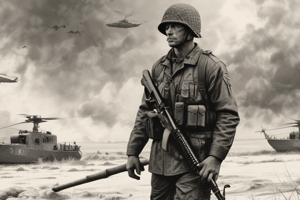Podcast
Questions and Answers
What was the primary objective of Operation Rolling Thunder during the Vietnam War?
What was the primary objective of Operation Rolling Thunder during the Vietnam War?
- To provide safety and rest spots along the Ho Chi Minh trail.
- To diminish North Vietnam's capacity to wage war by targeting its military and industrial assets. (correct)
- To deploy multi-role jets carrying 18,000 pounds of weapons in strategic locations.
- To focus on troop deployment numbers and enable PAVN/NLF to recover.
How did the USSR primarily support North Vietnam during the Vietnam War?
How did the USSR primarily support North Vietnam during the Vietnam War?
- By providing military equipment such as AK-47s and MIG jets. (correct)
- By initiating French education reforms to promote communist ideology among the elite class.
- By deploying a total of 8.7 million troops to assist in combat operations.
- By providing financial aid exceeding $276 billion between 1959 and 1975.
Why was the 'War of Attrition' strategy employed by the ARVN and USA forces not very effective during the Vietnam War?
Why was the 'War of Attrition' strategy employed by the ARVN and USA forces not very effective during the Vietnam War?
- It focused on diminishing troop numbers, but PAVN/NLF could recruit around 10k soldiers each month. (correct)
- It directly engaged in carpet bombing tactics, resulting in significant damage to the operational zones.
- It successfully diminished the recruitment capabilities of PAVN and NLF, leading to their inability to recover.
- It relied heavily on multi-role jets carrying 18,000 pounds of weapons without considering the local terrain.
What role did the 'tunnel systems' play in the war strategies of the PAVN and NLF?
What role did the 'tunnel systems' play in the war strategies of the PAVN and NLF?
What was the significance of the Gulf of Tonkin incident in escalating U.S. involvement in the Vietnam War?
What was the significance of the Gulf of Tonkin incident in escalating U.S. involvement in the Vietnam War?
How did the political structure of Vietnam before the Vietnam War contribute to long-term tensions?
How did the political structure of Vietnam before the Vietnam War contribute to long-term tensions?
What impact did the authoritarian rule of Diem have on the political climate in South Vietnam?
What impact did the authoritarian rule of Diem have on the political climate in South Vietnam?
How did China's support for North Vietnam influence the dynamics of the Vietnam War?
How did China's support for North Vietnam influence the dynamics of the Vietnam War?
What role did Agent Orange play in the Vietnam War, and what were its consequences?
What role did Agent Orange play in the Vietnam War, and what were its consequences?
What was the purpose of NLF infiltration and membership throughout villages and the countryside in Vietnam?
What was the purpose of NLF infiltration and membership throughout villages and the countryside in Vietnam?
Flashcards
La Corvée
La Corvée
A system of forced labor with little to no pay.
Domino Theory
Domino Theory
After the Korean War, the fear that communism would spread throughout Asia.
Gulf of Tonkin Incident
Gulf of Tonkin Incident
A controversial event that led to increased U.S. involvement in Vietnam. USS Maddox was allegedly attacked by North Vietnamese ships.
The 'Peasant's Gun'
The 'Peasant's Gun'
Signup and view all the flashcards
Tunnel Systems
Tunnel Systems
Signup and view all the flashcards
MIG Jets
MIG Jets
Signup and view all the flashcards
War of Attrition
War of Attrition
Signup and view all the flashcards
Operation Rolling Thunder
Operation Rolling Thunder
Signup and view all the flashcards
China's Key Objectives in Vietnam
China's Key Objectives in Vietnam
Signup and view all the flashcards
USSR's Increased Aid to Hanoi
USSR's Increased Aid to Hanoi
Signup and view all the flashcards
Study Notes
- There were both long and short term causes of the Vietnam War.
Long Term Causes of the Vietnam War
- Only 20% of boys from the elite class and social hierarchy received French education.
- The French used a system of forced labor called La Corvée, where local people worked for little to no pay.
- Communism in Vietnam was in opposition to the anti-communist sentiment growing in the United States.
- The French administrators and resident superiors always favored the French political structure.
Short Term Causes of the Vietnam War
- The First Indochina War and the Geneva Accords of 1954, along with growing fears of the Cold War in the US contributed to the war
- There was a fear that communism would spread throughout Asia after the Korean War ended in 1953; known as the domino theory
- Authoritarian Diem claimed that he "won 98.2% of the votes in the South", denounced the communists, and executed people suspected of being communist without proper trial, and practiced nepotism, which created tensions in the South.
- In August 1964, the USS Maddox was attacked by North Vietnamese ships in the Gulf of Tonkin.
- Although the U.S. Navy reported another attack on August 4, later evidence revealed that the attack never happened.
- The Tonkin Gulf Resolution resulted from the alleged attacks and led to an increase in American advisors: 23,000 before the incident in 1964, and 184,000 after the resolution in 1965.
Practices of War from PAVN & NLF perspective
- The AK-47 was a peasant's gun provided by the USSR and China, and transported through the Ho Chi Minh trails.
- Tunnel systems provided safe spots, rest stops, and a place for hiding, storing, and transporting supplies undetected.
- The USSR provided MIG Jets to defend North Vietnam from napalm bombing.
- The NLF infiltrated villages and countryside, which made it difficult to identify, easy to mobilize across many locations, and better for guerilla tactics.
Practices of War from ARVN & USA perspective
- Multi-Role Jets were used and carried 18,000 pounds of weapons.
- Operation Rolling Thunder (1965-1968) was the “Carpet Bombing” and attacked military, industrial infrastructure, and disabled 85 % of North Vietnam's petroleum storage and 70% of its power generation.
- The War of attrition was focused on wearing down troop numbers so that PAVN/NLF would be unable to recover.
- The War of Attrition was not very effective because PAVN could recruit around 10k soldiers each month.
Influence of foreign powers (USA)
- The USA provided a total of 8.7 million troops.
- Between 1959 and 1975, $276 billion was spent on the Vietnam War.
- The USA used 11.2 million gallons of Agent Orange, 3 gallons per acre.
- This prolonged the war.
- There were fewer casualties than opposition, which the US found good, but NV found indifferent.
Influence of foreign powers (US allies)
- South Korea provided the most troops and was in debt to the US after the Korean War.
- Canada provided $2.5 billion worth of materials and supplies.
- Taiwan provided transport aircraft.
- The Republic of Korea was paid by the US, and human mobilization was extremely brutal, resulting in the killing of 8-9k Vietnamese civilians.
- Australia manufactured helicopters, transport planes, and Canberra bombers.
Influence of foreign powers (China)
- China's Key objective was spreading communism throughout Asia, and had ties with Viet Minh.
- The Gulf of Tonkin increased their support.
- Between 1965-71, 320k Chinese troops were present, with 170k on the ground at one time in 1967.
- The peak of their economic aid was also in 1967, with $225 million.
- Between 1954-71, $1.8 Billion was spent.
- In 1950, China formed a diplomatic relationship with Hanoi.
- Some argue USSR and China aid / support caused the US's failure.
Influence of foreign powers (USSR)
- In 1950, the USSR acknowledged Ho Chi Minh's governance.
- The USSR originally denied military aid in order to preserve relations with Europe, and encouraged China to provide military support.
- A change in leadership with Alexei Kosygin made them more eager to assist, and they began to provide military aid in 1964.
- Increased aid to Hanoi in response to the US escalation in 1965.
- Communism was escalated in Asia in order to gain the upper hand within the western cold-war, which served Russian and Chinese interests.
- The USSR provided heavy machine guns and anti-aircraft batteries.
- The last year of the conflict, hand held anti- aircraft missiles were provided.
- The USSR provided Soviet SAM missiles (Surface to air missiles).
- The USSR had 3k soviet personnel between 1964-5.
- $3.6 billion was spent between 1954 and 1971.
Studying That Suits You
Use AI to generate personalized quizzes and flashcards to suit your learning preferences.




